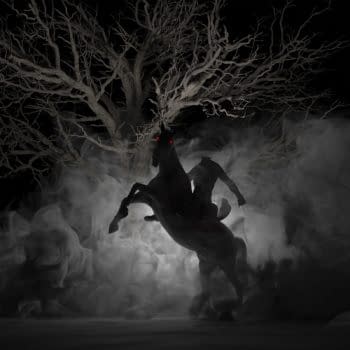Posted in: Movies, Recent Updates | Tagged: Candy Man, clive barker, entertainment, film, H.P. Lovecraft, hellraiser, horror films, Nightbreed, saw, slasher flms, stephen king
Celebrating Clive Barker's Contributions To Horror
By Brandon Engel
Clive Barker burst onto the horror scene in the 1980s with his The Books of Blood series, and he immediately began receiving praise from the industry's heaviest hitters, including Stephen King. Instead of remaining content with his role as a horror novelist, Barker embraced his many artistic leanings by branching out into playwriting, filmmaking, painting, video games, and even toy design. Although Barker has been noticeably influenced by H.P. Lovecraft, he is also a true visionary who has continuously created an impressive and original list of work that spans the horror and fantasy genres.
Hellraiser (1987)
[youtube]https://www.youtube.com/watch?v=P7TWm3Akw-s[/youtube]
Clive Barker's mainstream directorial debut, Hellraiser, was released in 1987, and it still holds up amazingly well. This stunning piece of cinema introduced horror audiences to an intriguing mixture of gore, sadomasochism and Cenobites, and it was based on Barker's novella "The Hellbound Heart."
The story is about a mysterious puzzle box that opens up a gateway to Hell. The gatekeepers of Hell are the Cenobites, led by the Pinhead (Doug Bradley) are sort of like a convergence point between Lovecraftian beasts and eighties goth/counterculture. One man almost manages to escape the cenobites by drinking human blood of live victims (lovingly supplied to him by his sister-in-law, with whom he had an affair). One of the most refreshing aspects of Hellraiser was Barker's decision to allow the story to develop at a slower pace. This is a throwback to British horror films of the sixties and seventies, and it creates a creepy mood that is not often found in modern horror movies. The introduction of Pinhead gave gorehounds a new character to root for, but it also enabled Barker to make a statement about religion. After all, Pinhead is the leader of a communal religious group, and this makes him a representation of Jesus, Satan or a hybrid of the two.
Nightbreed (1990)
[youtube]https://www.youtube.com/watch?v=3MntiEGXQFk[/youtube]
Barker's second time in the director's chair gave him the opportunity to showcase how vivid his imagination can be. The creatures in Nightbreed, which was based on the short story "Cabal," were unlike anything that had been seen on the big screen before. The film is about a young man named Aaron (Craig Sheffer) who is manipulated by his psychologist (David Cronenberg himself) into believing that he is a murderer. Aaron then goes to live in a cemetery called Midian, that's inhabited by a strange group of monsters and outcasts. It's a film that is told beautifully (although cryptically) through the visuals, and it left many filmgoers confused.
Unfortunately, Barker was not pleased with the final result of the theatrical version of Nightbreed, and he blamed its poor performance on marketing issues. Critics, on the other hand, attribute the film's failure to an incoherent storyline.
Horror audiences and fans of Barker's work have since embraced the 1990 movie, and this has led to Nightbreed being labeled as a cult film. Barker was also finally able to reconstruct the movie in 2014, and a director's cut is now available that has restored his original vision. Regardless of the critical or commercial failure that this film faced, it was still an important entry in Barker's career because it helped highlight the path that his illustrations and paintings would eventually take.
Candyman (1992)
[youtube]https://www.youtube.com/watch?v=T7sZOkYSPpE[/youtube]
After the disappointing experience of Nightbreed, Barker was understandably reluctant to direct the 1992 film Candyman. Fortunately, the short story "The Forbidden" was brought to life by director Bernard Rose, and the results were a critical and financial success.
The film takes the urban legend of Candyman (Tony Todd) who is supposedly summoned if his name is said repeatedly in front of a mirror, and places him in a crime ridden community in Chicago. It's up to a Chicago based academic (Virginia Madsen) decides to explore the origin of the myth, and in the process, discovers the truth about the Candyman.
Candyman benefited from being set in the real-life Cabrini-Green public housing projects. This area in Chicago was well-known for having a lot of crime and being filled with graffiti, and this perfectly suited the setting of a story about a mythological urban legend being brought to life by a skeptic. Unlike many other horror films that fall under the slasher sub-genre, Candyman is intelligent, utilizes a gorgeous score and does not give into the temptation to give the villain any silly catchphrases. This is a testament to the strength of Barker's original source material. The film is still a fixture of midnight screenings and it's become incredibly popular on niche TV networks (see more info here).
Barker's Influence on Filmmakers
Although slasher films were already starting to push the envelope when Hellraiser was released, it is obvious that many filmmakers, authors and artists have been heavily influenced by Barker's work. For example, the central theme of the Saw movies is based around tormenting people in order to enable them to gain a personal form of salvation, but this concept actually came from the religious elements of Hellraiser. Many filmmakers have also pushed forward with a heightened awareness of the visual and cerebral needs of their audience, and this can clearly be traced to the way that Barker brought these elements to the forefront in each of his films (and this, of course, contrasts his work sharply from his contemporaries who were chiefly concerned with perpetuating formulaic slashers).
Brandon Engel is a Chicago based blogger who writes about everything from old school comic books to gothic horror literature to environmental law. Follow him on Twitter: @BrandonEngel2















